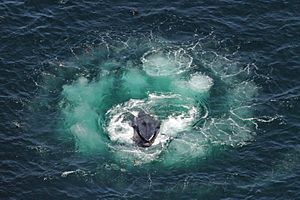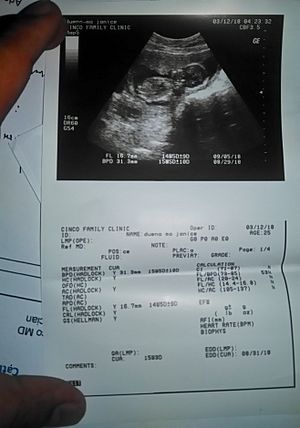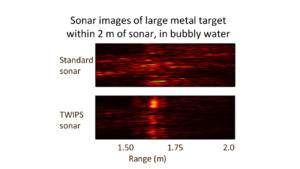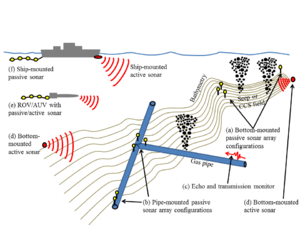Timothy Leighton facts for kids
Quick facts for kids
Timothy Leighton
FRS FREng FMedSci
|
|
|---|---|
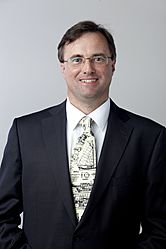
Leighton in 2014
|
|
| Born |
Timothy Grant Leighton
16 October 1963 Blackburn, Lancashire
|
| Education | Heversham Grammar School, Cumbria |
| Alma mater | University of Cambridge |
| Known for | The Acoustic Bubble |
| Awards |
|
| Scientific career | |
| Fields | |
| Institutions |
|
| Thesis | Image intensifier studies of sonoluminescence, with application to the safe use of medical ultrasound (1988) |
Timothy Grant Leighton (born 16 October 1963) is a British scientist. He is a top director and inventor at Sloan Water Technology Ltd. This company was started based on his amazing inventions.
Before this, he had a long career at universities. He is now an Honorary Fellow at Magdalene College, Cambridge University. He is also an Honorary Professor at University College London. The University of Southampton made him an Emeritus Professor of Ultrasonics and Underwater Acoustics. This was after he spent 10 years at Cambridge and over 30 years at Southampton.
Three important national groups have made him a Fellow. These include the Royal Society and the Academy of Medical Sciences. He studied physics and theoretical physics. He works in many different science areas. These include physical, medical, and ocean sciences. He also works in fluid dynamics and engineering.
When he was 28, he finished a big book called The Acoustic Bubble. He became a full professor at age 35. He has written over 500 scientific papers. He has won 8 international medals. He earned two doctorates from Cambridge University, one in 1988 and another in 2019.
Contents
Learning and Early Career
Timothy Leighton went to Heversham Grammar School in Cumbria. He then studied at Magdalene College, Cambridge. He earned a top degree in physics and theoretical physics in 1985. He completed his PhD at the Cavendish Laboratory in Cambridge in 1988.
After his PhD, he received special research grants. These allowed him to continue his studies at Magdalene College. In 1992, he joined the University of Southampton. He became a lecturer in underwater acoustics. In the same year, he finished his important book, The Acoustic Bubble. He became a full professor when he was 35 years old.
Amazing Research and Inventions
Timothy Leighton has led important research groups. These include Global-NAMRIP and HEFUA. He also started the Ultrasonics and Underwater Acoustics Group at the University of Southampton. He is the main inventor and director at Sloan Water Technology Ltd. He often talks to students and the public about his work.
His research helps in many areas. These include medicine, helping people, and the environment. He starts with complex math and ends with real-world tools. His work covers sound in the ocean, fighting superbugs, and medical ultrasound. He also studies climate change, cleaning, and preventing infections. He looks at how fluids move and how sound behaves underwater.
He believes in creating new technology that truly helps society. He thinks scientists should not just publish papers. They should also make sure their ideas become useful tools. He once said:
...We need to work with rigour, imagination, and wonder, unconstrained by the artificial boundaries set in place by discipline names... Then, when we eventually do find a solution, we must have the will to push it through all the way to help others, and not simply publish in the expectation that someone will finish the job for us.
He has studied how human-made sounds affect sea creatures living on the seabed. These creatures are called benthic species. They are important for keeping the ocean floor healthy. They cannot move away from loud sounds as easily as whales or fish.
His teams also found ways to see which fish are most at risk from ocean noise. They measured noise from ships. He also worked on using sound to guide fish away from dangerous areas. For example, he helped develop ways to protect young eels from being pulled into water pipes. He also created a theory to predict how fish are harmed when they pass through hydroelectric dams. These dams can cause serious injury or death to fish.
Global-NAMRIP: Fighting Superbugs
In 2015, Professor Leighton started the Global Network for AntiMicrobial Resistance and Infection Prevention (Global-NAMRIP). He led this group and helped fund it with his inventions until 2024. The group's main goal was to fight against superbugs and prevent infections.
Global-NAMRIP held many conferences. They never charged people to attend. They even paid for travel for some attendees from Africa. This helped scientists from different fields meet and work together. The group focused on solving real-world problems that could help patients and public health.
Health Effects of Ultrasound in Air
In 2015, Professor Leighton also started a research group called Health Effects of Ultrasound in Air (HEFUA). He wanted to understand how much ultrasound is used in public places. He also wanted to see if this increasing use was harming people. His research showed that existing safety rules were not good enough.
His 2016 report on this topic was downloaded over 20,000 times. It led to more research and discussions worldwide. High-power ultrasound in labs can cause burns or hearing changes. Lower-level ultrasound in public places can cause headaches, ringing in the ears, or nausea. It can also make it hard to focus.
Professor Leighton argued that the lowest frequency for ultrasound should be 17.8 kHz, not the usual 20 kHz. Many scientists now agree with this. People around the world are now tracking where ultrasound devices are used. His research helped teachers find out why some students in classrooms were affected by ultrasound that others could not hear.
He became an expert on how ultrasound affects people. He also looked into claims of "sonic attacks" on US Embassy staff. In 2018, he pointed out problems in how these incidents were studied. He showed that the tests might wrongly identify people as sick. In 2023, a US intelligence report agreed with his view. It said it was "very unlikely" that a foreign weapon caused the incidents.
He now works with international groups to protect people, especially children, from airborne ultrasound.
Sound in Space
Since the mid-2000s, Professor Leighton has been interested in using sound to explore other planets. He predicted what sounds might be like on other worlds. He also showed how acoustic devices could be used there. His work led to tools for planetariums to teach about space. He also showed how important careful math is when using sound sensors on other planets.
He has hosted special sessions and published papers on acoustics in space. He was also invited to help with the Mars Perseverance and Ingenuity missions.
Marine Animal Sounds
Professor Leighton explained how humpback whales use sound when they hunt with bubble nets. This explanation is now often shared on whale watching tours. He also explained how dolphins can use their sonar to find prey while making bubble nets. This is amazing because the bubbles should block their sonar.
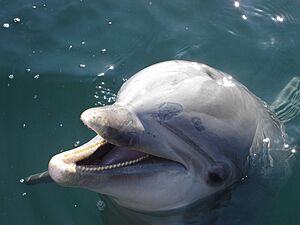
Inventions That Help People
Medical and Healthcare Inventions
Professor Leighton has invented systems for:
- Finding bone diseases like osteoporosis.
- Checking how well kidney stone treatments are working. This invention won an award in 2008.
- Needle-free injectors for people with migraines. Over 1 million of these have been sold.
He also helped the Institute of Cancer Research with technology to monitor cancer treatments in 2010.
He helped write guidelines for ultrasound scans during pregnancy. Because of these guidelines, two billion people have had safe ultrasound scans before they were born.
He has advised the UK government and international groups on the safety of ultrasound. Other medical inventions are mentioned under Global-NAMRIP and HEFUA.
Humanitarian Inventions
Professor Leighton invented:
- Radar to find buried explosives and hidden listening devices. It can also locate people buried in avalanches or collapsed buildings.
- The only sonar system that can find objects in bubbly water. This is important for protecting ships in conflict areas. It also helps find mines long after conflicts end.
- Systems to find objects buried in the seabed.
He also worked with the National Oceanography Centre on a system sold by Kongsberg. This system is used for finding old artifacts and for building projects. He is also helping young business owners in Africa get clean water from waste.
Environmental and Safety Inventions
Professor Leighton:
- Did an experiment that showed much more carbon dioxide dissolves into the oceans than previously thought. This is important for understanding climate change.
- Invented technology for environmental groups and oil companies. This technology monitors undersea gas leaks from pipelines and methane seeps using sound.
- Created a theory for using sonar to measure gas leaks from carbon capture sites under the sea. This was tested in large trials in the North Sea.
- Developed systems to measure methane in the seabed. Methane is a powerful greenhouse gas. Knowing how much is there and how much leaks out is very important for climate change.
- Created theories for measuring how gases move between the atmosphere and the ocean. This helps with climate change models.
- His inventions also help keep the world's most powerful neutron source safe in the United States.
Sloan Water Technology Ltd.
In the late 1980s, Professor Leighton found a new type of ultrasonic signal. He realized it came from waves on the surface of gas bubbles in liquids. His research turned this discovery into Sloan Water Technology Ltd. His work was so important that it also led to many other useful inventions.
Awards and Honors
Medals
- The 2017 Clifford Paterson Lecture and Medal from the Royal Society.
- The 2014 Rayleigh Medal from the Institute of Acoustics.
- The 2013 Helmholtz-Rayleigh Interdisciplinary Silver Medal.
- The 2009 R W B Stephens Medal.
- The 2006 Paterson Medal.
- The first 2004 Early Career Medal and Award.
- The 2002 Tyndall Medal.
- The 1994 A. B. Wood Medal.
The Institute of Physics said in 2006 that Timothy Leighton's work is amazing. They said he is a world leader in four fields. He has made over 70 new discoveries. These range from hospital devices to counting bubbles in ocean waves. His work is based on strong physics.
Other Awards
- Doctor of Science from Cambridge University in 2019.
- Royal Society's Lord Leonard and Lady Estelle Wolfson Foundation Translation Award in 2018.
- 'Best new product of the year' award for StarStream in 2014.
- Institute of Chemical Engineering Award for Water Management and Supply in 2012.
- Royal Society Brian Mercer Award for Innovation in 2011.
- 'Medical & Healthcare' award from 'The Engineer' in 2008.
- The first International Medwin Prize for Acoustical Oceanography in 2001.
Fellowships
Professor Leighton is a Fellow of three National Academies. He became a Fellow of the Royal Society (FRS) in 2014. This honor recognized his research on the physics of bubbles and his many inventions. These include ways to measure bubbles, monitor medical treatments, and create needle-free injections.
In 2018, he became a Fellow of the Academy of Medical Sciences. This was for using physics to help patients. His book The Acoustic Bubble (published when he was 29) laid the groundwork for much research on medical ultrasound. He is known for turning ideas into real products.
He became a Fellow of the Royal Academy of Engineering (FREng) in 2012 for his contributions to engineering. He is also a Fellow of the Institute of Physics, the Institute of Acoustics, and the Acoustical Society of America. In 2018, he was given the highest rank of Distinguished Fellow by the International Institute of Acoustics and Vibration.
Sharing Science and Helping Others
Professor Leighton loves to share his passion for science. He has won many awards for his outreach work. He visits schools, attends science fairs, and creates exhibits and games. He also appears on TV and radio to encourage young people to study science and engineering.
He designed a game called "The most dangerous game in the world." This game helps people learn about superbugs and how to protect themselves. A government minister even mentioned his work in 2017. A book once described him as "a middle-aged Harry Potter."
Charity Work
Professor Leighton helped start the Solent Concert Orchestra. He has been its chairperson for most of its existence. The orchestra performs three concerts each year. They raise money for many charities, often helping smaller ones that do not get national attention.




